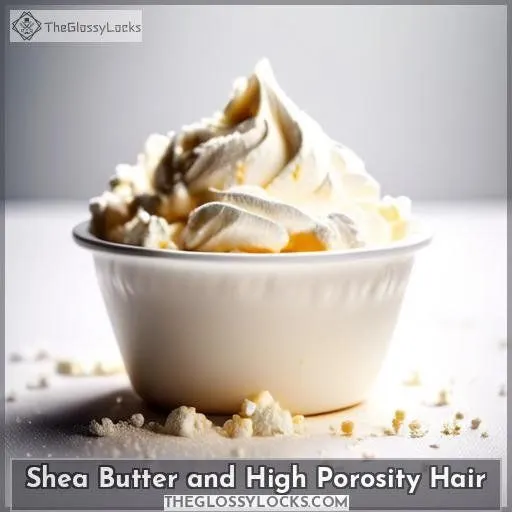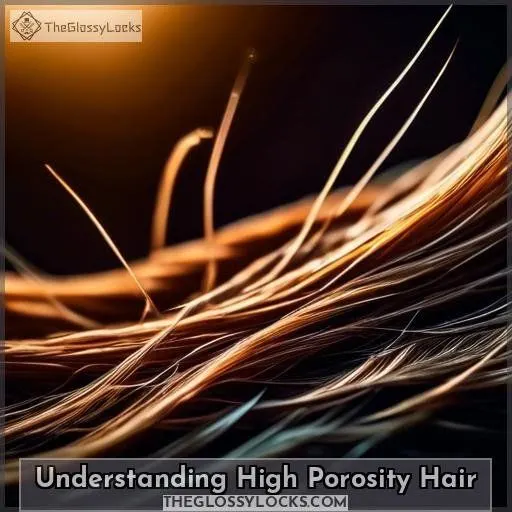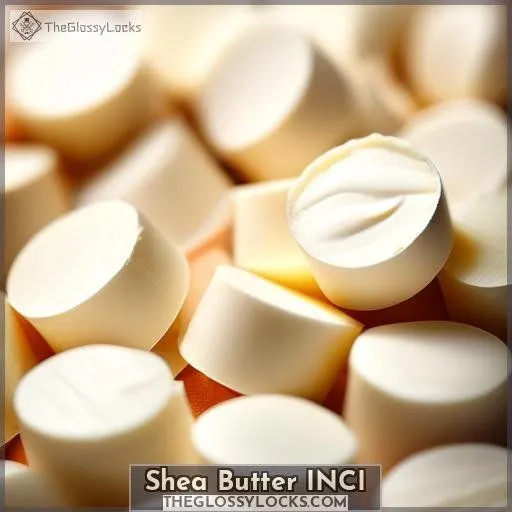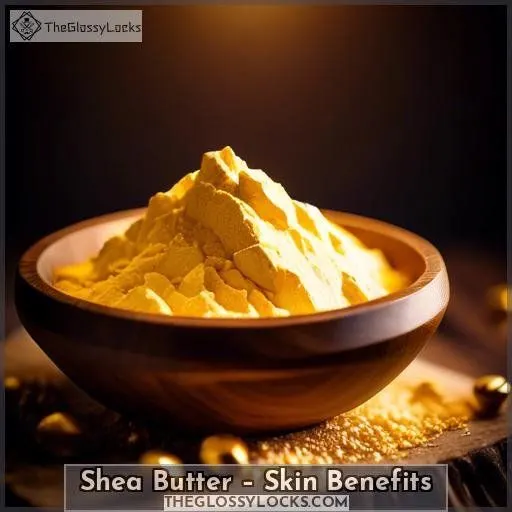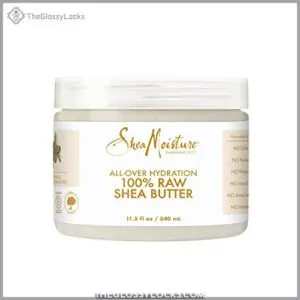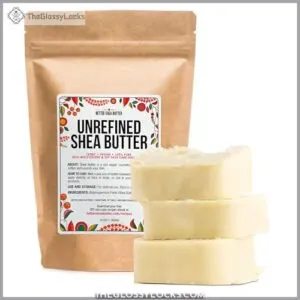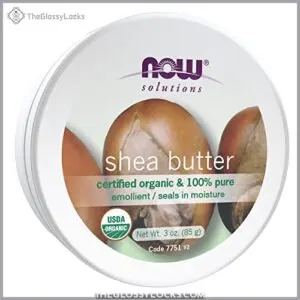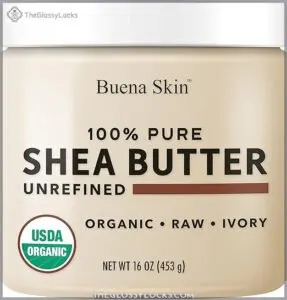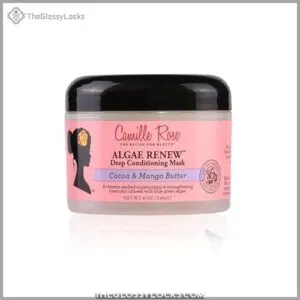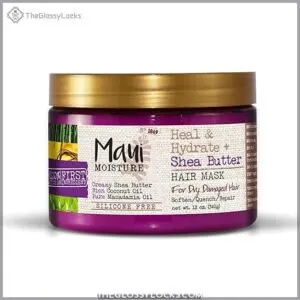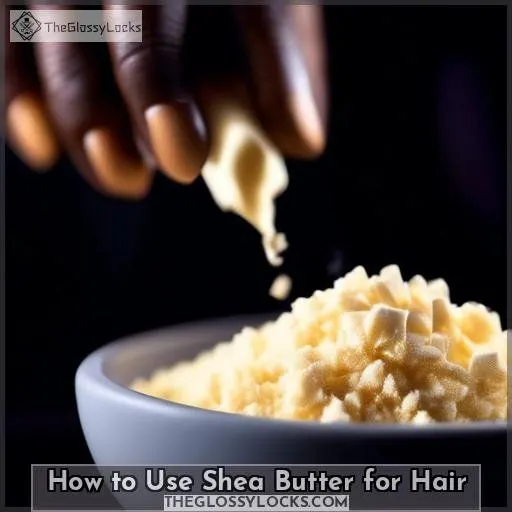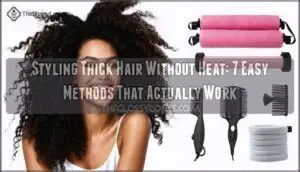This site is supported by our readers. We may earn a commission, at no cost to you, if you purchase through links.
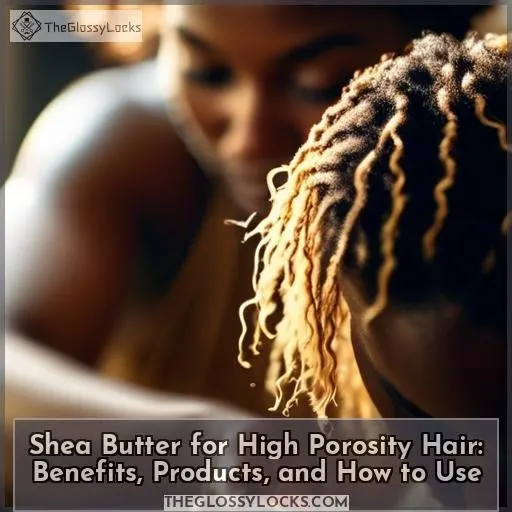
Yes, you can use shea butter for high porosity hair.
Shea butter is a powerhouse ingredient that deeply moisturizes and seals in hydration, addressing the key concerns of this hair type prone to dryness and damage.
Its rich fatty acids nourish and strengthen strands, preventing frizz and breakage while enhancing natural shine.
As an emollient, shea butter softens and improves manageability.
It is perfect for replenishing thirsty, porous strands that struggle to retain moisture.
Want to learn more about harnessing shea butter’s benefits for gorgeous, healthy tresses?
Table Of Contents
- Key Takeaways
- Can I Use Shea Butter for High Porosity Hair?
- Shea Butter and High Porosity Hair
- Understanding High Porosity Hair
- Shea Butter INCI
- Shea Butter – Refined or Unrefined?
- Shea Butter – Properties. How Does It Work?
- Shea Butter – Skin Benefits
- Shea Butter. Which Hair Type is It Good For?
- 7 Best Shea Butter Products for Hair
- 1. Shea Moisture All Over Hydration Dry Skin
- 2. Pure African Shea Butter Moisturizing Dry Skin
- 3. Certified Organic Shea Butter Moisturizer
- 4. Raw African Organic Shea Butter 16 Oz
- 5. Camille Rose Algae Renew Deep Conditioning Hair Mask
- 6. Maui Moisture Heal and Hydrate Shea Butter Hair Mask
- 7. Carol’s Daughter Black Vanilla Leave in Conditioner
- How to Use Shea Butter for Hair
- The Takeaway
- Frequently Asked Questions (FAQs)
- Conclusion
Key Takeaways
- Shea butter can be used for high porosity hair, as it deeply moisturizes and seals in hydration, addressing the key concerns of this hair type prone to dryness and damage.
- High porosity hair, which is characterized by a dry, coarse texture and a tendency to absorb moisture quickly, requires a different approach to hair care.
- When using shea butter for high porosity hair, it’s crucial to start with a deep conditioner to test your hair’s reaction.
- To use shea butter effectively on high porosity hair, consider using it as part of your deep conditioning routine, applying it from root to tip, and focusing on the ends for fine or low porosity hair.
Can I Use Shea Butter for High Porosity Hair?
Yes, you can use shea butter for high porosity hair. Shea butter is known for its moisturizing properties and can help lock in moisture, preventing frizziness in high porosity hair. It can also protect your hair from heat and UV rays, which is beneficial for high porosity hair.
However, it is essential to use shea butter in moderation, as it can leave your hair feeling greasy and lank in high doses due to its richness. It is recommended to use shea butter-based deep conditioners or styling products for high porosity hair to test its effects and see if it suits your hair type.
Shea Butter and High Porosity Hair
Shea butter, a popular plant butter known for its moisturizing properties, is often recommended for low porosity hair due to its ability to provide permanent protection and enhance the hair’s natural shine. However, it isn’t suitable for high porosity hair as it can make the hair frizzy and worsen its condition. High porosity hair, which is characterized by a dry, coarse texture and a tendency to absorb moisture quickly, requires a different approach to hair care.
If you have high porosity hair, it’s essential to avoid overloading your hair with heavy products, as this can weigh it down and cause frizziness. Instead, focus on using lightweight, water-based conditioners and leave-ins that can help lock in moisture without leaving your hair feeling greasy. Additionally, consider using a leave-in conditioner or a hair oil infused with shea butter to provide extra hydration and protection for your hair.
When using shea butter for high porosity hair, it’s crucial to start with a deep conditioner to test your hair’s reaction. If your hair feels stringy after using shea butter, it may not be the best product for your hair type. Instead, opt for lighter, more breathable products that can help manage your hair’s natural texture and prevent frizziness.
Understanding High Porosity Hair
High porosity hair is often characterized by its tendency to absorb moisture quickly and lose it just as fast. This type of hair needs extra care and attention to maintain its health and moisture levels.
- Hair Health: High porosity hair is prone to damage and breakage due to its increased moisture absorption and loss.
- Moisture Retention: It’s crucial to maintain moisture levels in high porosity hair to prevent dryness and damage.
- Porosity Test: A porosity test can help determine if your hair is high porosity. Look for signs like hair feeling hard and dry, products not penetrating, and hair absorbing water quickly.
- Hair Care Routine: Regular deep conditioning, using the right hair products, and gentle handling are essential for high porosity hair.
- Hair Products: Opt for products that provide moisture without weighing down the hair, like the Mizani MoisturFusion conditioner.
Shea Butter INCI
So, you’ve got the lowdown on high porosity hair and are ready to dive into the world of shea butter. Let’s talk about the INCI, or the International Nomenclature of Cosmetic Ingredients, for this golden elixir. Known in the biz as Butyrospermum Parkii Butter, this natural wonder is a godsend for thirsty locks that just can’t seem to hold onto moisture.
Shea butter is chock-full of fatty acids that are like a tall glass of water for high porosity hair. These lipids slip into the hair’s open cuticles, quenching them from the inside out and encouraging hair growth. It’s like a VIP treatment for your strands, giving them the strength to face the world, come rain or shine.
Now, don’t get it twisted; while shea butter is a heavyweight champ in the moisturizing ring, it’s not going to leave your hair feeling like it’s been dunked in a deep fryer. Nope, it’s got just the right touch to smooth things over without the grease factor. So, if you’re looking to give your high porosity hair some love, shea butter’s your new best friend.
Shea Butter – Refined or Unrefined?
When it comes to shea butter for high porosity hair, the choice between refined and unrefined shea butter can make all the difference. Refined shea butter has been processed to remove impurities, but it may lose some of its nutrients in the process. Unrefined shea butter, on the other hand, retains more of its natural nutrients, making it a better choice for hair care.
Shea butter extraction is crucial for its preservation and sustainability. The grades of shea butter vary, with the highest quality being raw, unrefined, and organic. Refined shea butter is often bleached and deodorized, which can affect its nutrient content and sustainability.
If you’re considering shea butter substitutes, it’s essential to note that they may not provide the same benefits as shea butter. For high porosity hair, unrefined shea butter can deeply moisturize and create an occlusive barrier to prevent water loss, leaving hair feeling softer and smoother.
Shea Butter – Properties. How Does It Work?
Having explored the debate between refined and unrefined shea butter, let’s dive into the heart of shea butter’s magic. You’re about to discover why this natural wonder is a game-changer for your hair, especially if you’re juggling the challenges of high porosity locks.
- Shea Butter’s Hydrating Power: This solid gold (well, technically, ivory) is a hydration hero. Its rich composition deeply moisturizes hair, leaving it feeling lush and lively.
- Sealing in Moisture: Not just a one-hit wonder, shea butter creates a protective barrier around each strand. This means the moisture you work so hard to infuse into your hair doesn’t just vanish like a magician’s rabbit.
- Softness and Manageability: Imagine running your fingers through your hair and feeling silk instead of straw. Shea butter turns that dream into reality, making detangling a breeze.
- Scalp Soothing: It’s not all about the strands; your scalp gets some love too. Shea butter’s anti-inflammatory properties keep the scalp calm and comfortable.
Whether you’re battling with the frizz monster or trying to coax your curls into submission, incorporating shea butter into your routine could be your secret weapon. Let’s not forget, the right products and usage methods can elevate your hair game to legendary status.
Shea Butter – Skin Benefits
You’re right to consider shea butter’s skin benefits when evaluating its use for high porosity hair. This natural wonder deeply moisturizes, slows skin aging, and provides natural UV protection – no surprise given its rich vitamin and antioxidant content.
Moisturizing Properties
Shea butter is a popular natural ingredient for hair care, especially for those with high porosity hair. It’s known for its excellent moisturizing properties, which can be particularly beneficial for hair that tends to dry out quickly or needs extra hydration.
- Deep Conditioning: Shea butter is great for deep conditioning, as it can penetrate the hair shaft and provide long-lasting moisture. This is especially important for high porosity hair, which tends to lose moisture quickly.
- Hydration: Shea butter can help improve the overall hydration of your hair, making it look and feel softer and smoother. It’s rich in fatty acids and vitamins A and E, which are known for their nourishing and moisturizing properties.
- Protection: Shea butter can also serve as a protective barrier for your hair, shielding it from environmental stressors and damage. This is particularly useful for those who live in areas with harsh weather conditions or who use heat styling tools frequently.
- Moisture Retention: Shea butter can help improve moisture retention in your hair, which is crucial for maintaining healthy, hydrated locks. It can help seal in moisture and prevent dryness, which is a common issue for high porosity hair.
To get the most out of shea butter for your hair, consider using it as part of your deep conditioning routine. Apply it to your hair before shampooing or use it as a leave-in treatment. You can also mix it with other natural oils or ingredients to create a custom hair mask. Remember, it’s always a good idea to patch test any new product on a small section of your hair before applying it to your entire head.
Skin Aging Prevention
Shea butter is a powerful ally in the fight against skin aging.
Its rich antioxidant content helps protect your skin from the damaging effects of free radicals.
While its phytosterols and allantoin work together to strengthen your skin’s barrier function.
This means that shea butter can help your skin retain moisture and resist the signs of aging.
It’s also a great choice for those with sensitive skin, as it can help soothe eczema and reduce inflammation.
Natural UV Protection
Shea butter is a natural product that provides protection from the sun’s harmful rays and other environmental stressors.
It can be used as a heat protectant before styling your hair, especially for those with low porosity hair, which tends to be more susceptible to heat damage.
To use shea butter as a heat protectant, apply it to your hair before styling with heat tools. This will help shield your hair from the damaging effects of heat, ensuring that your hair remains healthy and vibrant.
Shea Butter. Which Hair Type is It Good For?
Shea butter, a popular plant butter, is often recommended for low porosity hair due to its deep moisturizing properties. However, it isn’t suitable for high porosity hair, as it may worsen the condition and make it frizzy. Low porosity hair has a tightly sealed cuticle, which makes it difficult for moisture to penetrate and can lead to dryness or frizziness. In contrast, high porosity hair has a more open cuticle, allowing moisture to enter and exit quickly, which can result in dryness and damage.
Shea butter is rich in phytosterols, antioxidants, allantoin, vitamins A, E, F, and valuable fatty acids, making it an excellent moisturizer for both skin and hair. It’s particularly beneficial for low porosity hair, as it provides permanent and necessary protection, smooths hair for easy combing, and controls scalp moisture.
To use shea butter effectively on low porosity hair, consider the following tips:
- Start with a deep conditioner to test your hair’s reaction to shea butter.
- If your hair feels stringy after applying shea butter, it may not be suitable for your hair type.
- Use shea butter as a leave-in conditioner or mix it with other ingredients for a DIY mask.
- Apply it from root to tip for high-porosity or coarse hair, focusing on the ends for fine or low-porosity hair.
7 Best Shea Butter Products for Hair
For high porosity hair that craves extra moisture, consider these top shea butter products:
Shea Moisture All Over Hydration Dry Skin
Pure African Shea Butter Moisturizing Dry Skin
Certified Organic Shea Butter Moisturizer
Raw African Organic Shea Butter 16 Oz
Camille Rose Algae Renew Deep Conditioning Hair Mask
Maui Moisture Heal and Hydrate Shea Butter Hair Mask
Carol’s Daughter Black Vanilla Leave-in Conditioner
These trusted formulas harness the nourishing power of shea butter to quench thirsty strands and restore suppleness.
1. Shea Moisture All Over Hydration Dry Skin
If you’re seeking a product to hydrate your dry skin, look no further than Shea Moisture All Over Hydration Dry Skin. This product is designed to provide your skin with the moisture it needs to thrive. The key ingredient in this formula is shea butter, which is renowned for its ability to replenish the skin with vitamins A and D and essential fatty acids. This product is made with fair trade shea butter, ensuring that you’re not only getting high-quality ingredients but also supporting ethical business practices.
To use this product, simply apply it to your dry skin and massage it in gently. The texture may be grainy in the container due to the natural shea butter solidifying below normal room temperature, but this can be easily remedied by melting it at a low temperature and freezing it back in the container. The earthy/nutty scent of shea butter may be present, but it’s not overpowering. The consistency of the product varies from smooth to grainy depending on the cooling process, but this doesn’t affect its efficacy.
When using Shea Moisture All Over Hydration Dry Skin, remember that a little goes a long way. Apply it sparingly and use it as often as needed to maintain hydrated, healthy skin. This product is suitable for all skin types and can be used on both the face and body. With regular use, you’ll notice a significant improvement in the appearance and feel of your skin.
Best For:
Shea Moisture All Over Hydration Dry Skin is best for those with dry skin who are looking for a product to deeply moisturize and hydrate their skin.
- Made with 100% certified organic Shea Butter, ethically sourced from women’s cooperatives in Northern Ghana
- Replenishes skin with vitamins A and D and essential fatty acids
- Soothes dry scalp and conditions hair
- Protects hair from heat and softens skin and hair
- Suitable for all skin types
- Can be used on both the face and body
- No sulfates, parabens, phthalates, propylene glycol, mineral oil, animal testing, or petroleum
- May have a grainy texture due to natural Shea Butter solidifying below normal room temperature
- Scent may be earthy/nutty due to the natural Shea Butter
- Application should be sparing, as a little goes a long way
2. Pure African Shea Butter Moisturizing Dry Skin
If you have low porosity hair, you can consider using Pure African Shea Butter Moisturizing Dry Skin for your hair care routine.
This product is known for its moisturizing properties and can be used on all skin types, including sensitive skin.
It’s suitable for dry skin and can be used as a DIY body butter or for soap making.
The butter is easy to apply and can enhance your skin’s natural glow.
It’s also versatile and can be used to create various skincare products.
Best For:
- People with dry skin or low porosity hair
- Those seeking a natural, unrefined moisturizer for skin and hair
- Individuals interested in DIY skincare and soap making
- Those looking for a product suitable for all skin types, including sensitive skin
- Moisturizes and nourishes dry skin and hair
- Suitable for all skin types, including sensitive skin
- Can be used in DIY skincare products and soap making
- Enhances skin’s natural glow
- Softens and detangles hair
- Regenerates new skin
- Non-greasy
- Versatile and can be used on various parts of the body
- May not be ideal for those with oily skin due to its thickness
- Has a strong, waxy odor that some may find unpleasant
- Can be hard and require heating before use, which may be a hassle for some
- Can clog pores in naturally oily skin, hindering the moisture from being absorbed into the skin
- May not be suitable for acne-prone skin as it may clog pores and lead to more breakouts
- May not be effective for sun protection as it has an SPF of about three or four, which is too small to prevent sun damage or sunburn on its own
3. Certified Organic Shea Butter Moisturizer
To truly understand the benefits of shea butter for high porosity hair, it’s crucial to delve into the realm of certified organic shea butter moisturizer. This top-notch product is a game-changer for those seeking to unlock the secrets of optimal hair care. Not only does it provide a deep dive into the world of shea butter, but it’s also designed to enhance your hair care routine in a way that’s tailored to your specific needs.
Certified organic shea butter moisturizer is a meticulously crafted product that’s worth considering for those seeking a comprehensive solution. It’s not merely a moisturizer; it’s a complex system that’s ever-evolving to meet the everchanging needs of high porosity hair.
To ensure you’re getting the most out of this product, it’s essential to note that it’s designed to penetrate the hair shaft, providing a deep conditioning experience that’s unparalleled. It’s important to remember that shea butter is rich in phytosterols, antioxidants, allantoin, vitamins A, E, F, and valuable fatty acids, which all work together to create an occlusive barrier on the skin and hair, preventing water loss and leaving your hair feeling softer and smoother.
When it comes to using certified organic shea butter moisturizer, it’s advisable to follow a few considerations. Firstly, it’s important to assess your hair type and determine if it’s suitable for high porosity hair. If it is, you can dive in and unleash the full potential of this product.
To get the most out of your certified organic shea butter moisturizer, it’s vital to follow the instructions provided by the manufacturer. This may include applying the product to damp hair, massaging it into your scalp, and leaving it on for a specified amount of time before rinsing it out. It’s also important to note that shea butter can be used as a scalp moisturizer, ensuring that your hair care routine is comprehensive and covers all aspects of your hair’s health.
Best For:
Best for those with high porosity hair seeking a deep conditioning experience with a product that’s ever-evolving to meet their specific needs.
- Contains phytosterols, antioxidants, allantoin, vitamins A, E, F, and valuable fatty acids that work together to create an occlusive barrier, preventing water loss and leaving hair feeling softer and smoother.
- Can be used as a scalp moisturizer, ensuring a comprehensive hair care routine.
- GMP Quality Assured and packaged in the USA.
- Family owned and operated company since 1968.
- Specific instructions for use may vary depending on the manufacturer, so it’s important to follow the guidelines provided.
- Some users may find the texture too rich or heavy for their liking.
- The product may not be suitable for those with low porosity hair, as it is designed for high porosity hair types.
4. Raw African Organic Shea Butter 16 Oz
If you’re looking for a high-quality, organic shea butter to enhance your hair care routine, you’ve come to the right place. The Raw African Organic Shea Butter 16 Oz is a top-notch choice, offering a multitude of benefits for your hair. This product is ethically sourced from Shea trees in Burkina Faso and undergoes a grade A extraction method to ensure its purity and effectiveness. It’s also USDA certified organic, vegan, and free of artificial colors, fragrances, fillers, and GMOs.
This raw and unrefined shea butter is perfect for those seeking a natural, all-natural product that deeply moisturizes and protects their hair. It can be used alone or mixed with other ingredients for a DIY mask, or applied with other hair care products like leave-in conditioners, curl creams, mousses, or hair oils. It’s particularly suitable for high-porosity hair, which tends to be dry and damaged, as it helps to smooth and moisturize the hair.
When using shea butter on your hair, it’s essential to start with a deep conditioner to test your hair’s reaction. If your hair feels stringy, shea butter may not be the best choice for you. Additionally, when applying shea butter, focus on the ends for fine or low-porosity hair, and apply from root to tip for high-porosity or coarse hair. For easy application, storage, and customization, whip the shea butter before use.
Best For:
- Individuals seeking a high-quality, organic shea butter for hair care
- Those with dry, damaged, or high-porosity hair
- People looking for a natural, all-natural product with moisturizing and protective properties
- Ethically sourced from Shea trees in Burkina Faso
- Undergoes a grade A extraction method for purity and effectiveness
- USDA certified organic, vegan, and free of artificial colors, fragrances, fillers, and GMOs
- Raw and unrefined, retaining its natural nutrients and vitamins
- Multipurpose for various hair care needs, including dry skin, chapped lips, and preventing stretch marks
- Can be used alone or mixed with other hair care products
- Helps protect the face from extreme temperatures and is great for dry skin during winter months
- Soothes the irritation of psoriasis
- May help reduce acne and scarring
- May be difficult to get out of the jar due to its thick, luxurious consistency
- Some users may find the earthy, smokey scent unpleasant
5. Camille Rose Algae Renew Deep Conditioning Hair Mask
Camille Rose Algae Renew Deep Conditioning Mask is a popular choice for those with high porosity hair. This conditioner is packed with vitamin-rich blue algae, unrefined cocoa and mango butter, and biotin for healthy growth and strength. It’s designed to deeply condition and nourish hair, leaving it with shiny, healthy-looking results.
To use the Algae Renew Deep Conditioner, apply an ample amount to dry or wet hair, leave it on for 10 minutes, and rinse with cool water. For extra conditioning, you can apply heat for a minimum of 20 minutes by wearing a plastic cap. The conditioner is suitable for all hair types and can help improve hair cell regrowth, prevent shedding, and soften and moisturize dry, moisture-craving hair.
The Algae Renew Deep Conditioning Mask is infused with a blend of pure blue green algae, which is rich in vitamins, minerals, and antioxidants. Unrefined cocoa and mango butters are also included for maximum moisture benefits, and growth-stimulating biotin extracted from algae is infused to create a softening mix for all hair types.
Ingredients in the Algae Renew Deep Conditioning Mask include deionized water, aloe vera juice, unrefined shea butter, coconut oil, behentrimonium methosulfate, cocoa butter, mango seed butter, hemp seed oil, panthenol, manuka honey, green tea extract, jojoba seed oil, rosehip fruit oil, grape seed oil, evening primrose oil, phenoxyethanol, caprylyl glycol, blue green algae, dimethyl sulfone (MSM), biotin, vitamin E, peppermint oil, and fragrance.
Best For:
The Camille Rose Algae Renew Deep Conditioning Mask is best for individuals with high porosity hair, as it is designed to deeply condition and nourish hair, leaving it with shiny, healthy-looking results.
- Infused with vitamin-rich blue algae, unrefined cocoa and mango butter, and biotin for healthy growth and strength
- Suitable for all hair types
- Can help improve hair cell regrowth, prevent shedding, and soften and moisturize dry, moisture-craving hair
- Can be used with heat for extra conditioning
- Leaves hair feeling soft and frizz-free
- Pleasant and sweet fragrance
- Does not cause scalp itchiness
- Expensive, but worth the money
- May be too little product for the price
- Double-layered plastic packaging is wasteful
6. Maui Moisture Heal and Hydrate Shea Butter Hair Mask
If your curls are crying out for a serious moisture boost, the Maui Moisture Heal and Hydrate Shea Butter Hair Mask might just be your hair’s new best friend.
This 12 oz. jar of goodness is a multitasker, doubling as a hair mask and leave-in treatment.
It’s like a spa day for your strands, especially if you’ve got wavy to tight curls that are on the thirstier side.
The vegan formula is chock-full of aloe vera, shea butter, coconut oil, and macadamia oil, making it a sulfate-free and paraben-free option for those looking to avoid harsh chemicals.
It’s designed to drench your hair in moisture, repair those pesky split ends, and leave your curls feeling softer than a cloud in a cartoon.
And for those of you who’ve colored your hair every shade under the sun, no worries—it’s safe for color-treated hair too.
Just remember, while it’s a hit for many, some users find it less moisturizing than expected, and the coconut scent might make you feel like you’re on a tropical island (which isn’t a bad thing, unless you’re not a fan of coconuts!).
Best For: The Maui Moisture Heal and Hydrate Shea Butter Hair Mask is best for individuals with wavy to tight curls and medium to dry moisture levels who are seeking a vegan, sulfate-free, and paraben-free hair care solution.
- Deeply quenches and nourishes dry, damaged hair
- Repairs and softens curls
- Mends split ends
- Not as moisturizing as some users hoped
- Can leave hair feeling squeaky when used as a conditioner
- Has a strong coconut scent
7. Carol’s Daughter Black Vanilla Leave in Conditioner
If you’re seeking a leave-in conditioner that can transform your dry, dull, and brittle hair into soft and manageable strands, look no further than Carol’s Daughter Black Vanilla Moisture & Shine Leave-In Conditioner. This weightless formula is designed to restore natural moisture and add strength to your hair, making it an excellent choice for those with high porosity hair.
The blend of wheat protein and pro-vitamin B5 fortifies your hair, strengthening it and preventing breakage during detangling. The conditioner is made with natural moisturizers instead of synthetic silicones, ensuring that the hydration it provides doesn’t rinse away and won’t weigh down your hair.
To use the conditioner, simply hold it 6 to 8 inches away from your hair and spray it all over. It can be applied to both wet and dry hair, making it a versatile option for those with high porosity hair. If you’re looking to refresh your style on dry hair, this leave-in conditioner is the perfect choice.
Carol’s Daughter Black Vanilla Moisture & Shine Leave-In Conditioner is also suitable for those with naturally curly hair, from 4c curly hairstyles to 1c waves. It’s a top-notch choice for anyone seeking to improve the manageability of their high porosity hair and add shine to their locks.
Best For:
Best For: Those with dry, dull, and brittle hair seeking to restore natural moisture, improve manageability, and add shine to their locks. This product is suitable for high porosity hair and is ideal for those with naturally curly hair, from 4c curly hairstyles to 1c waves.
- Restores Natural Moisture: The conditioner is formulated with wheat protein and pro-vitamin B5, which nourishes and strengthens damaged hair fibers, repairs, provides strength, elasticity, and softness.
- Adds Shine: The conditioner is designed to add shine to your hair without weighing it down, making it an excellent choice for those with high porosity hair.
- Detangles Hair: The product is formulated to detangle and detoxify damaged tresses, making it easier to manage and style your hair.
- Packaging May Vary: The packaging may not always match the product description, which could be a potential issue for some customers.
- Strong Scent: The black vanilla scent is quite strong, which may not be preferred by everyone.
- Not Intended for Internal Use: The conditioner is not intended for internal use, so it should be kept out of eyes and not ingested.
How to Use Shea Butter for Hair
Now that you’ve learned about the benefits of shea butter for high porosity hair, it’s time to dive into how to use it effectively.
- Choose the Right Shea Butter Product: Start by selecting a high-quality shea butter product that suits your hair type and porosity. Look for products that are rich in shea butter and other nourishing ingredients.
- Prepare Your Hair: Before applying shea butter, ensure your hair is clean and damp. This will help the butter penetrate better.
- Apply Shea Butter: Use your fingers or a comb to work the shea butter into your hair, starting from the ends and working your way up to the roots. Be gentle to avoid breakage.
- Leave It On: Depending on the product, you may need to leave the shea butter on for a while to allow it to work its magic. Follow the instructions on the product packaging for the best results.
- Rinse and Style: After the recommended time, rinse out the shea butter and style your hair as usual. You’ll notice the difference in the softness, manageability, and overall health of your hair.
The Takeaway
Shea butter is a popular ingredient in hair care products, especially for those with high porosity hair. High porosity hair tends to absorb moisture quickly but loses it just as fast, making it crucial to maintain the right balance of moisture and protein. Shea butter can help maintain this balance by providing a protective layer that locks in moisture and prevents water loss.
When using shea butter for hair care, it’s essential to consider the type of hair you have. High-porosity hair benefits from the moisturizing and smoothing properties of shea butter, while low-porosity hair may find it too heavy. To ensure optimal results, it’s crucial to assess your hair’s needs and choose products accordingly.
When it comes to shea butter products, there are several options available. Some popular choices include the Shea Moisture All Over Hydration Dry Skin, Pure African Shea Butter Moisturizing Dry Skin, and Camille Rose Algae Renew Deep Conditioning Hair Mask. These products are designed to provide the right balance of moisture and protein for high porosity hair.
To use shea butter effectively, start with a deep conditioner to test your hair’s reaction. If your hair feels stringy, shea butter may not be suitable. Instead, consider using a lightweight leave-in conditioner or a product that combines shea butter with other ingredients to create a more balanced formula.
Frequently Asked Questions (FAQs)
Can shea butter cause buildup?
Yes, shea butter can potentially cause buildup, especially on low-porosity hair. Start with small amounts and focus on the ends to avoid heaviness or greasiness.
How long should I leave shea butter in my hair?
As the saying goes, a little goes a long way. For high-porosity hair, leave shea butter on for 15-30 minutes before rinsing thoroughly.
Can I use shea butter on wet hair?
Yes, you can apply shea butter to wet hair. In fact, using it on damp strands allows better absorption and seals in moisture. Start with a small amount and focus on the ends to avoid weighing down your hair.
Can I use shea butter with other oils?
Sure, you can mix shea butter with other oils for added benefits. Just remember, with high porosity hair, heavy oils like shea can weigh it down, so use sparingly.
Can I use shea butter on braids or twists?
Yes, you can absolutely use shea butter on braids or twists! It’s a fantastic sealant that’ll help lock in moisture and prevent frizz.
Conclusion
Like a radiant sun nourishing parched soil, shea butter rejuvenates high porosity hair, sealing in moisture with its rich fatty acids. You’ll achieve gorgeous, healthy tresses by harnessing its emollient properties that soften and improve manageability. Incorporate shea butter products into your routine to replenish thirsty, porous strands and experience the transformation.

